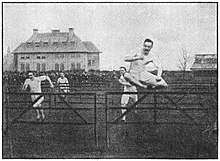Detroit Athletic Club
The Detroit Athletic Club (often referred to as the DAC) is a private social club and athletic club located in the heart of Detroit's theater, sports, and entertainment district. It is located across the street from Detroit's historic Music Hall. The clubhouse was designed by Albert Kahn and inspired by Rome's Palazzo Farnese. It maintains reciprocal agreements for their members at other private clubs worldwide. It contains full-service athletic facilities, pools, restaurants, ballrooms, and guest rooms. Members include business professionals of all types as well as professional athletes. Ty Cobb is among the athletes to have been a member of the DAC. The building is visible beyond center field from Comerica Park.[1]
| Detroit Athletic Club | |
|---|---|

| |
| General information | |
| Type | private club |
| Architectural style | Neo-Renaissance style |
| Location | 241 Madison Street Detroit, Michigan 48226 |
| Coordinates | 42.337468°N 83.047355°W |
| Completed | 1915, 2012 |
| Technical details | |
| Floor count | 7 |
| Design and construction | |
| Architect | Albert Kahn |
History

The Detroit Athletic Club was founded in 1887 to encourage amateur athletic activities, and built a clubhouse with a tract in what is now Detroit's Cultural Center. Henry Joy, son of the man who built the Michigan Central into one of the nation's most successful large railroads, served as president of the Packard Motor Car Company in the early decades of the last century. He felt that the rich new titans of the booming automobile industry spent too much time in the Woodward Avenue pubs. He thought they needed a club commensurate with this stature. On January 4, 1913, Joy and 108 other leading Detroit citizens came together to reorient the Detroit Athletic Club. Joy and his colleagues selected Detroit's most accomplished architect, Albert Kahn.
People
Kahn, in 1912, had visited Italy and was inspired by the buildings he saw there. Two of Detroit's most impressive current downtown edifices—the Detroit Athletic Club and the Police Department headquarters on Beaubien—reflect what Kahn saw in Italy. The Palazzo Borghese in Rome provided Kahn with a model for much of the Detroit Athletic Club, but the idea of using the large impressive windows for the impressive fourth floor dining room—called the Grill Room—came from the Palazzo Farnese. In the 1990s, the membership devoted substantial fund to a major refurbishing of the attractive building.
Over the years, the Detroit Athletic Club has provided financial assistance and training opportunities for a number of amateur athletes preparing for the Olympic Games.
At the 1956 U.S. Olympic Team Trials, springboard divers Jeanne Stunyo (a native of Gary, Indiana) and Mackenzie High School graduate Barbara Gilders-Dudeck were sponsored by the DAC. Stunyo and Gilders-Dudeck qualified for the Summer Olympic Games in Melbourne, Australia. At the Games, Jeanne Stunyo won the springboard diving silver medal, and Barbara Gilders-Dudeck finished in fourth place - less than one point from a bronze medal.[2]
A. Duncan Carse created paintings to decorate the Detroit Athletic Club. The paintings were covered at the club but they were on show again after a remodeling of the club in 1999.[3]
See also
- 1956 Summer Olympics
- List of American gentlemen's clubs
- Sports in Detroit
References
- Hill, Eric J.; John Gallagher (2002). AIA Detroit: The American Institute of Architects Guide to Detroit Architecture. Wayne State University Press. ISBN 0-8143-3120-3.
- Voyles, Kenneth H.; John Bluth (2001). The Detroit Athletic Club: 1887-2001. Arcadia Publishing. ISBN 0-7385-1901-4.
- Voyles, Kenneth H.; Bluth, John A. (2001). The Detroit Athletic Club, 1887-2001. Chicago, IL: Arcadia Pub. p. 123. ISBN 0738519014.
Further reading
- Hill, Eric J.; John Gallagher (2002). AIA Detroit: The American Institute of Architects Guide to Detroit Architecture. Wayne State University Press. ISBN 0-8143-3120-3.
- Meyer, Katherine Mattingly and Martin C.P. McElroy with Introduction by W. Hawkins Ferry, Hon A.I.A. (1980). Detroit Architecture A.I.A. Guide Revised Edition. Wayne State University Press. ISBN 0-8143-1651-4.CS1 maint: multiple names: authors list (link)
- Sobocinski, Melanie Grunow (2005). Detroit and Rome: building on the past. Regents of the University of Michigan. ISBN 0-933691-09-2.
- Voyles, Kenneth H.; John Bluth (2001). The Detroit Athletic Club: 1887-2001. Arcadia Publishing. ISBN 0-7385-1901-4.
- Voyles, Kenneth H.; John Bluth (2001). The Detroit Athletic Club: 1887-2001. Arcadia Publishing. ISBN 0-7385-1901-4.